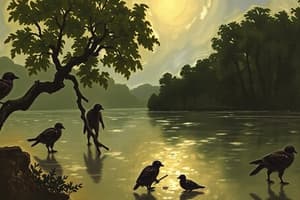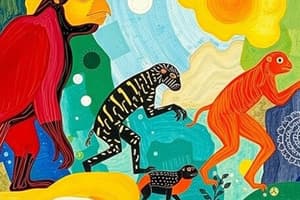Podcast
Questions and Answers
What is the primary effect of mountains on weather patterns in relation to the rainshadow effect?
What is the primary effect of mountains on weather patterns in relation to the rainshadow effect?
- Mountains block moist air, creating wet windward and dry leeward sides. (correct)
- Mountains cause both sides to receive equal rainfall.
- Mountains are irrelevant to local climate patterns.
- Mountains attract moisture from the ocean.
Which of the following ecosystems is characterized by cold, treeless regions with permafrost?
Which of the following ecosystems is characterized by cold, treeless regions with permafrost?
- Tundra (correct)
- Taiga
- Savannas
- Temperate Deciduous Forests
Where do the light-dependent reactions of photosynthesis primarily occur?
Where do the light-dependent reactions of photosynthesis primarily occur?
- In the nucleus
- In the mitochondria
- In the cytoplasm
- In the thylakoid membranes (correct)
What do plants produce as a direct result of light-dependent reactions during photosynthesis?
What do plants produce as a direct result of light-dependent reactions during photosynthesis?
Which stage of cellular respiration occurs in the cytoplasm?
Which stage of cellular respiration occurs in the cytoplasm?
What is the main energy currency produced during cellular respiration?
What is the main energy currency produced during cellular respiration?
In which part of the chloroplasts does the Calvin Cycle take place?
In which part of the chloroplasts does the Calvin Cycle take place?
Which characteristic defines savannas as an ecosystem?
Which characteristic defines savannas as an ecosystem?
Which mechanism of evolution explains how more offspring are produced than can survive?
Which mechanism of evolution explains how more offspring are produced than can survive?
Which type of evidence provides connections between ancient species and their modern descendants?
Which type of evidence provides connections between ancient species and their modern descendants?
Which scientist is known for proposing the theory of natural selection based on his observations of finches in the Galapagos Islands?
Which scientist is known for proposing the theory of natural selection based on his observations of finches in the Galapagos Islands?
What type of structures indicate common ancestry among different species, such as the arm of a human and the wing of a bat?
What type of structures indicate common ancestry among different species, such as the arm of a human and the wing of a bat?
What does 'descent with modification' refer to in the process of evolution?
What does 'descent with modification' refer to in the process of evolution?
Which of the following is an example of artificial selection?
Which of the following is an example of artificial selection?
What is the term for structures that are reduced or no longer in use, providing evidence of evolutionary history?
What is the term for structures that are reduced or no longer in use, providing evidence of evolutionary history?
How do biochemical comparisons contribute to understanding evolution?
How do biochemical comparisons contribute to understanding evolution?
What is the primary purpose of taxonomy in biology?
What is the primary purpose of taxonomy in biology?
Which component is NOT considered an abiotic factor in an ecosystem?
Which component is NOT considered an abiotic factor in an ecosystem?
What effect does the tilt of the Earth's axis have on ecosystems?
What effect does the tilt of the Earth's axis have on ecosystems?
Which latitude zone is characterized by warm, wet climates and high biodiversity?
Which latitude zone is characterized by warm, wet climates and high biodiversity?
How does altitude generally affect ecosystems?
How does altitude generally affect ecosystems?
What is the primary role of producers in an ecosystem?
What is the primary role of producers in an ecosystem?
What is the influence of ocean currents on climates?
What is the influence of ocean currents on climates?
What is indicated by nutrient cycling in ecosystems?
What is indicated by nutrient cycling in ecosystems?
What are the main outputs of glycolysis?
What are the main outputs of glycolysis?
Which of the following correctly describes the Krebs Cycle?
Which of the following correctly describes the Krebs Cycle?
What is the primary function of the Electron Transport Chain?
What is the primary function of the Electron Transport Chain?
How do photosynthesis and cellular respiration differ in their purpose?
How do photosynthesis and cellular respiration differ in their purpose?
What type of interaction is represented when bees pollinate flowers while obtaining nectar?
What type of interaction is represented when bees pollinate flowers while obtaining nectar?
In which type of biotic relationship does one species benefit while the other is unaffected?
In which type of biotic relationship does one species benefit while the other is unaffected?
What are the inputs required for cellular respiration?
What are the inputs required for cellular respiration?
Which of the following best describes intraspecific interactions?
Which of the following best describes intraspecific interactions?
What is an example of parasitism?
What is an example of parasitism?
Which type of competition occurs between different species?
Which type of competition occurs between different species?
Which relationship is characterized by one species benefiting and the other being harmed?
Which relationship is characterized by one species benefiting and the other being harmed?
What impact do keystone species have on their ecosystem?
What impact do keystone species have on their ecosystem?
What is the main outcome of intraspecific competition?
What is the main outcome of intraspecific competition?
How do herbivores potentially influence plant evolution?
How do herbivores potentially influence plant evolution?
What is facilitation in ecological terms?
What is facilitation in ecological terms?
What is a significant role of biotic relationships within ecosystems?
What is a significant role of biotic relationships within ecosystems?
Flashcards
Evolution
Evolution
The change in species over time due to genetic variation and natural selection.
Natural Selection
Natural Selection
The process where organisms with favorable traits are more likely to survive and reproduce.
Fossil Evidence
Fossil Evidence
Fossils show how species have changed over time and reveal transitional forms.
Homologous Structures
Homologous Structures
Signup and view all the flashcards
Vestigial Structures
Vestigial Structures
Signup and view all the flashcards
Artificial Selection
Artificial Selection
Signup and view all the flashcards
Overproduction of offspring
Overproduction of offspring
Signup and view all the flashcards
Adaptation
Adaptation
Signup and view all the flashcards
Taxonomy definition
Taxonomy definition
Signup and view all the flashcards
Ecosystem definition
Ecosystem definition
Signup and view all the flashcards
Ecosystem components
Ecosystem components
Signup and view all the flashcards
Earth's rotation effect
Earth's rotation effect
Signup and view all the flashcards
Earth's axis tilt effect
Earth's axis tilt effect
Signup and view all the flashcards
Latitude's effect on climate
Latitude's effect on climate
Signup and view all the flashcards
Ocean proximity effect
Ocean proximity effect
Signup and view all the flashcards
Importance of taxonomy
Importance of taxonomy
Signup and view all the flashcards
Rainshadow effect
Rainshadow effect
Signup and view all the flashcards
Tropical Rainforest
Tropical Rainforest
Signup and view all the flashcards
Savanna
Savanna
Signup and view all the flashcards
Photosynthesis
Photosynthesis
Signup and view all the flashcards
Chlorophyll
Chlorophyll
Signup and view all the flashcards
Cellular Respiration
Cellular Respiration
Signup and view all the flashcards
Mitochondria
Mitochondria
Signup and view all the flashcards
Glycolysis
Glycolysis
Signup and view all the flashcards
Cellular Respiration Input
Cellular Respiration Input
Signup and view all the flashcards
Cellular Respiration Output
Cellular Respiration Output
Signup and view all the flashcards
Photosynthesis Reactants
Photosynthesis Reactants
Signup and view all the flashcards
Photosynthesis Products
Photosynthesis Products
Signup and view all the flashcards
Mutualism Biotic Relation
Mutualism Biotic Relation
Signup and view all the flashcards
Commensalism Biotic Relation
Commensalism Biotic Relation
Signup and view all the flashcards
Krebs Cycle's Location
Krebs Cycle's Location
Signup and view all the flashcards
Electron Transport Chain Location
Electron Transport Chain Location
Signup and view all the flashcards
Parasitism
Parasitism
Signup and view all the flashcards
Competition
Competition
Signup and view all the flashcards
Predation
Predation
Signup and view all the flashcards
Herbivory
Herbivory
Signup and view all the flashcards
Amensalism
Amensalism
Signup and view all the flashcards
Keystone Species
Keystone Species
Signup and view all the flashcards
Symbiosis
Symbiosis
Signup and view all the flashcards
Facilitation
Facilitation
Signup and view all the flashcards
Study Notes
Evolution and Taxonomy
- Evolution: The process of species changing over time through genetic variation and natural selection.
- Evolution explains: The diversity of life on Earth.
- Natural Selection (Darwin): The mechanism of evolution where species change through genetic variation.
- Alfred Russel Wallace: Independently developed the idea of natural selection.
- Jean-Baptiste Lamarck: Proposed inheritance of acquired traits, though later disproven.
- Charles Lyell: Proposed uniformitarianism—the idea that present-day geological processes shaped Earth's past.
Evidence for Evolution
- Fossil Evidence: Shows changes in species over time; transitional fossils link ancient species to modern descendants (e.g., Archaeopteryx).
- Anatomical Evidence: Homologous structures (similar structures in different species indicating common ancestry, e.g., human arm, bat wing, whale flipper) and vestigial structures (reduced or unused structures indicating evolutionary history, e.g., human tailbone).
- Biochemical Evidence: DNA and protein comparisons show similarities among species; more closely related species have more similar genetic sequences.
Natural Selection in Detail
- Mechanisms of Natural Selection:
- Overproduction of offspring: More offspring are produced than can survive.
- Variation: Individuals in a population vary.
- Adaptation: Traits that provide survival advantages become more common in descendants.
- Descent with Modification: Over generations, populations evolve.
- Key Examples: Peppered moth and Darwin's finches' beak adaptations.
Taxonomy and Classification
- Taxonomy: The science of naming, describing, and classifying organisms.
- Hierarchical System (Carl Linnaeus): Domain, Kingdom, Phylum, Class, Order, Family, Genus, Species.
- Importance of Taxonomy: Helps organize biological diversity and understand evolutionary relationships.
- Modern Taxonomy: Uses phylogenetics (evolutionary trees) and molecular data (DNA sequencing) to classify species.
Ecosystems
- Ecosystem Definition: A community of living organisms (biotic factors) interacting with their non-living environment (abiotic factors).
- Ecosystem Examples: Forests, deserts, wetlands.
- Ecosystem Components: Biotic (plants, animals, microbes); abiotic (climate, soil, water, sunlight).
- Energy Flow: From producers to consumers (animals) and decomposers.
- Nutrient Cycling: Carbon, nitrogen, and water cycles sustain life.
- Ecosystem Variations by Location:
- Earth's Rotation: Causes day/night, wind patterns, and photosynthesis.
- Earth's Axis Tilt: Causes seasons.
- Latitude: Determines climate zones.
- Proximity to the Sea: Moderates coastal climates.
- Ocean Currents, Altitude, Wind Patterns, Rainshadow Effect
Major Ecosystems (Biomes)
- Major Biomes: Tropical Rainforests, Savannas, Deserts, Grasslands, Temperate Deciduous Forests, Taiga, Tundra.
Energy Flow: Photosynthesis and Cellular Respiration
- Photosynthesis: Plants, algae, and some bacteria convert light energy into chemical energy (glucose).
- Photosynthesis Location: Chloroplasts, specifically thylakoid membranes and the stroma.
- Photosynthesis Key Molecule: Chlorophyll absorbs sunlight.
- Photosynthesis Stages:
- Light-Dependent Reactions: Convert light energy into chemical energy.
- Light-Independent Reactions (Calvin Cycle): Use chemical energy to build glucose.
- Cellular Respiration: Organisms break down glucose to release energy as ATP.
- Cellular Respiration Location: Cytoplasm (glycolysis) and mitochondria (Krebs cycle, electron transport chain).
- Cellular Respiration Stages: Glycolysis, Krebs Cycle (Citric Acid Cycle), Electron Transport Chain.
Biotic Relationships
- Biotic Relationships: Interactions between living organisms.
- Types of Interactions:
- Intraspecific: Between members of the same species.
- Interspecific: Between members of different species.
- Mutualism: Both species benefit (+ +).
- Commensalism: One species benefits, the other is unaffected (+ 0).
- Parasitism: One species benefits, the other is harmed (+ -).
- Competition: Both species are harmed (- -).
- Predation: One species hunts and kills another (+ -).
- Herbivory: An animal feeds on plants (+ -).
- Amensalism: One species is harmed, the other is unaffected (- 0).
- Keystone Species: Species with a disproportionately large impact on their ecosystem.
- Symbiosis: Close, long-term interactions between species (includes mutualism, commensalism, parasitism).
- Facilitation: Indirect positive effect of one species on another.
Studying That Suits You
Use AI to generate personalized quizzes and flashcards to suit your learning preferences.




